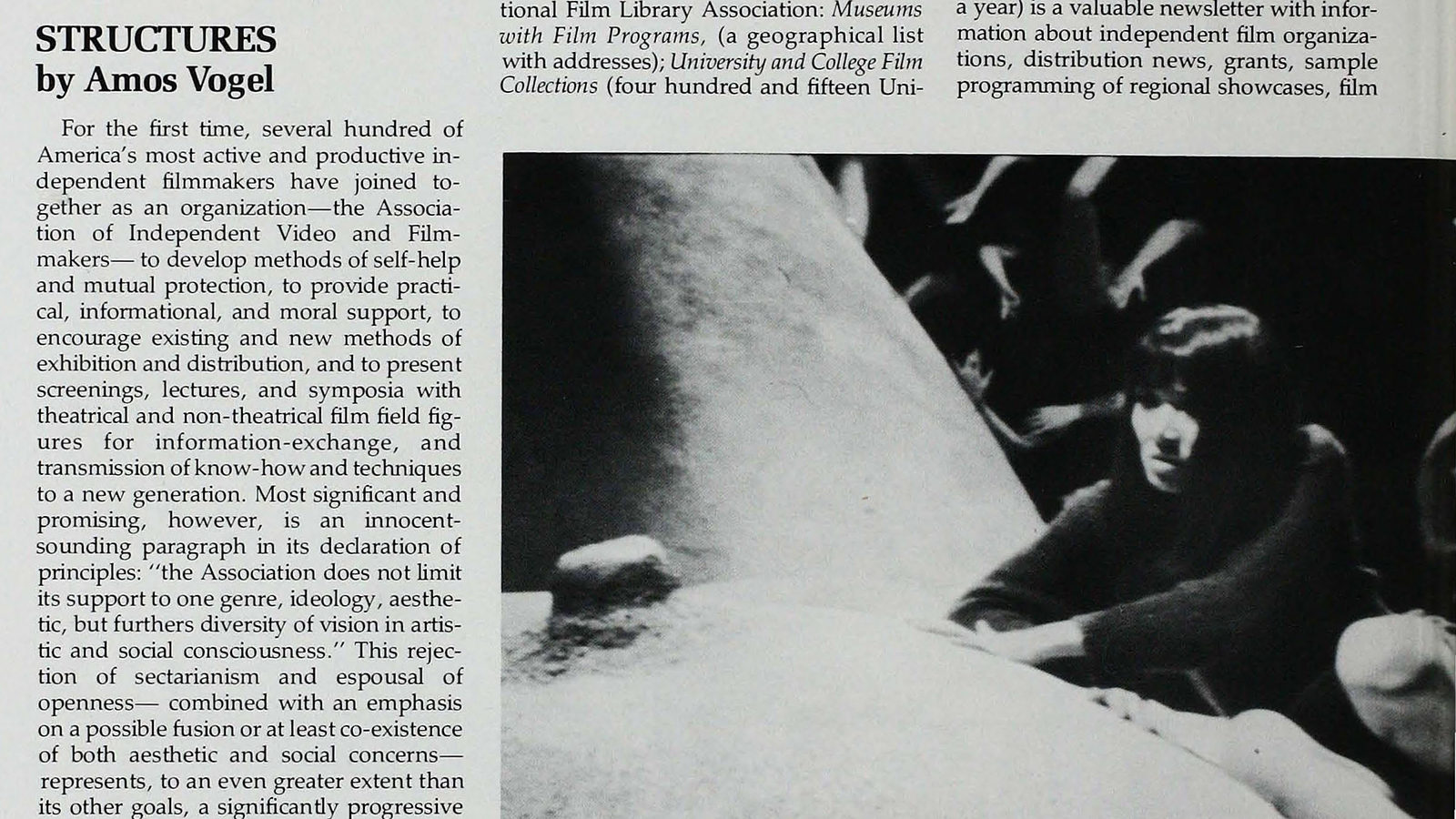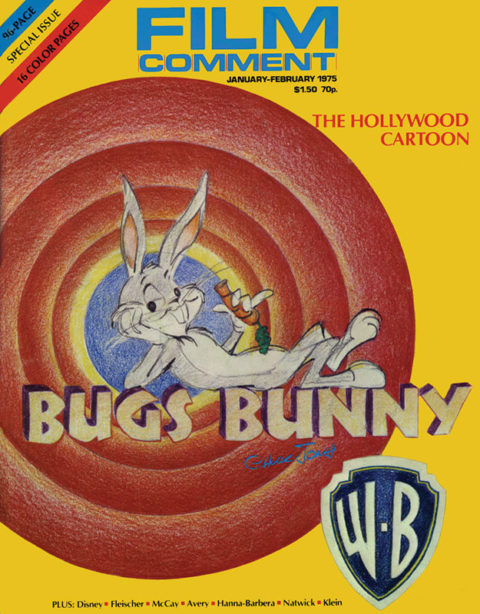By Amos Vogel in the January-February 1975 Issue

Independents: Structures
On recent organizations formed by independent filmmakers
For the first time, several hundred of America's most active and productive independent filmmakers have joined together as an organization—the Association of Independent Video and Filmmakers—to develop methods of self-help and mutual protection, to provide practical, informational, and moral support, to encourage existing and new methods of exhibition and distribution, and to present screenings, lectures, and symposia with theatrical and non-theatrical film field figures for information-exchange, and transmission of know-how and techniques to a new generation. Most significant and promising, however, is an innocent-sounding paragraph in its declaration of principles: “the Association does not limit its support to one genre, ideology, aesthetic, but furthers diversity of vision in artistic and social consciousness.” This rejection of sectarianism and espousal of openness—combined with an emphasis on a possible fusion or at least co-existence of both aesthetic and social concerns—represents, to an even greater extent than its other goals, a significantly progressive attitude that requires encouragement and support. Regular memberships are $10; so are associate non-voting memberships (available to anyone supporting the principles and work of the Association). If you only wish to receive mailings, the cost is $3. (Address Ed Lynch, Association of Independent Video and Filmmakers, 81 Leonard Street, New York, N.Y. 10013.)
The Society for the Anthropology of Visual Communications is a new organization for researchers, scholars, and practitioners “studying human behavior in context through visual means” who are interested in the study, use and production of anthropological films; the analysis of visual symbolic forms from a cultural-historical framework; visual theories, technologies, and methodologies for recording and analyzing behavior and different modes of communication; and the cross-cultural study of art and artifacts from a social, cultural, historical, and aesthetic viewpoint. The Society publishes Studies in the Anthropology of Visual Communications (a magazine), special publications, and filmographies. Their titles (and membership information) are available from The Society for the Anthropology of Visual Communications, American Anthropological Association, 1703 New Hampshire Avenue N.W., Washington, D.C. 20009.
New publications useful in obvious and subtle ways to both filmmakers and film-users are now available from the Educational Film Library Association: Museums with Film Programs, (a geographical list with addresses); University and College Film Collections (four hundred and fifteen University film libraries by state, size of collection, budget, and personnel); and Non-Theatrical Film Distributors: Sales Service Policies (with information on preview and sales policies of one hundred and thirty-seven companies and types of films handled). EFLA also distributes three filmographies: Aging (a comprehensive, critically annotated list of a hundred and thirty films for and about older people); Alternatives (an annotated list of a hundred and twenty films dealing with alternatives in education, life-styles, work, and religion); and Death and Dying (reviewing thirty-five films on the subject). They will be delighted to provide membership information and data concerning their annual American Film Festival, the definitive orgy of nontheatrical films of all categories. (EFLA, 17 West Sixtieth Street, New York, N.Y. 10023.)
The Bulletin for Film and Video Information (c/o Anthology Film Archives, 80 Wooster Street, New York, N.Y. 10012, $2 a year) is a valuable newsletter with information about independent film organizations, distribution news, grants, sample programming of regional showcases, film festivals, bibliographies (including magazine articles and special publications), and even reprints of a few articles or artists’ statements. A caveat: While the information provided is first-class, it is slanted strongly toward the “formal” (structuralist? minimalist?) avant-garde with which Anthology and Mekas are concerned; other newsletters addressing themselves to “the rest” of the independent field (eighty per cent?) would be advisable.
Showcase of the Month Award: to the First Avenue Screening Room and its indefatigable sleuth-cineaste-programmer Fabiano Canosa, who, within barely more than a year, has transformed a failing New York theater into an entirely new type of repertory theater that assiduously stays away from the usual repertory staples, stressing instead the young new talents (many as yet not well known and sorely in need of exposure) as well as neglected masterpieces by older directors or curios of the past. Consider so me of the titles: Oshima’s DEATH BY HANGING, Masumura’s WAREHOUSE, Herzog’s FATA MORGANA, Gomez’ FIRST CHARGE OF THE MACHETE, Rocha’s BLACK GOD, WHITE DEVIL, Arzner’s DANCE, GIRL, DANCE, Bruck’s I. F. STONE’S WEEKLY, Makavejev’s MAN IS NOT A BIRD, Osheroff’s DREAMS AND NIGHTMARES, Guerra’s THE GUNS, Delvaux’ THE MAN WHO HAD HIS HAIR CUT SHORT, Fassbinder’s ALI, Mehrjui’s THE cow. The emphasis here is clearly not on shorts or the American underground, but on features · (at times close to the commercial area in its creative aspects), Third World films, neglected countries, social and aesthetic concerns. For sample programs, address Fabiano Canosa, First Avenue Screening. Room, First Avenue at Sixty-First Street, New York, N.Y. 10021.
Creation of False Myths Department: Watch out for the splendiferous, rapidly emerging new Leni Riefenstahl myth (in America, not Europe where they know better), according to which she is not merely a great filmmaker (a fact on which all are agreed) but only made innocuous, “factual” “documentaries,” with neither the films nor the filmmaker organically related to Nazism. The new myth is assiduously abetted by the most unlikely combination of rightist, leftist, and politically innocent/ignorant forces and media ever assembled into one eclectic mass of sycophantic adorationists who, in the name of a spurious objectivity, vainly attempt to separate Leni’s splendid (even magnificent) form-style-aesthetics from her nefarious (even deadly) content-subject matter. More anon.








